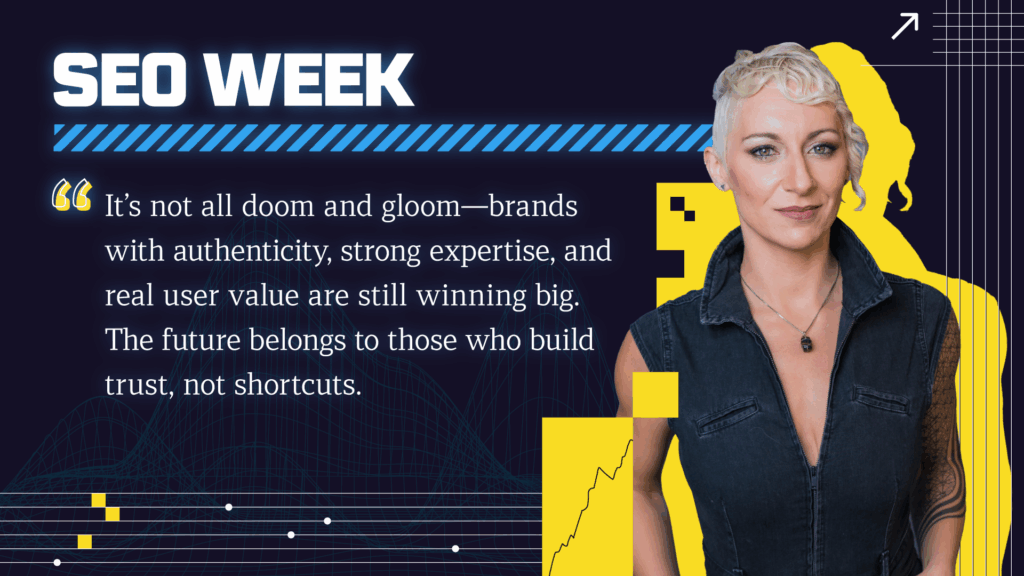In 2020, consumers spent $861.02 billion online in the U.S.
That’s a 44% jump compared to 2019. It’s also the largest increase in over twenty years.
According to Digital Commerce 360, ecommerce now accounts for 21.3% of all retail sales, up from 14.3% in 2018. The competition among brands will be fierce as ecommerce adoption continues to grow. Content is the tiebreaker that determines which brands win customer trust and market share.
Your content plays a critical role in the buyer’s journey.
With the right content strategy, your organization can harness the consumer shift to ecommerce, dramatically boosting top-line growth. In this article, learn how content plays a critical role in the buyer’s journey of an eCommerce brand. Discover why it’s important to develop a strategy for creating and distributing content. We’ll map out the basic steps you need to take to plan, document, and execute your strategy.
Why content strategy for ecommerce matters
According to Statista, 91% of organizations worldwide use content marketing. What’s interesting about this is the fact that only 46% spent $10K annually. In fact, most organizations allot 30% of their marketing budget or less to content marketing.
This made sense in the past.
Direct response played a more prominent role in the marketing mix. Things are different these days; consumers today are increasingly bombarded with advertising. As a result, a growing number of consumers (27% in 2021) rely on adblockers to avoid what they view as intrusive advertising.
Content marketing fills the void left by advertising.
Here’s the problem.
Customers are struggling with information overload. The value of content is undeniable, but so is its capacity to overwhelm. Researchers found that information overload frequently occurs if the content consumers read is:
- Ambiguous: Content concepts are unclear or uncertain, requiring readers to fill in the blanks for themselves
- Complex: This could be content that’s highly technical, specialized, or filled with lots of terms and jargon
- Debatable, risky, or controversial content decreases processing fluency, forcing readers to slow down and evaluate content carefully
- Excessive: Too many choices, too much information, too many terms, details, or minutia to go through
- New: Content that’s new decreases processing fluency; it requires readers to invest more brain power to process what’s in front of them
This is why your content strategy matters.
Ecommerce brands train buyers to ignore them when they use their content marketing indiscriminately or go against the wants and needs of their target audience.
But the majority of brands have a content strategy!
In 2020, 43% of B2B marketers and 42% of B2C marketers had a documented content strategy in place. It seems the majority of brands are already on the right track.
Only they aren’t.
According to Statista’s 2021 content marketing trend survey:
- 68% of B2B and 67% of B2C marketers felt their content strategy was “somewhat successful“
- 20% of B2B and 19% of B2C marketers felt their strategy was “not very successful“
- 2% of B2B and 3% of B2C marketers felt their strategy was “not successful“
- 10% of B2B and 11% of B2C marketers felt their strategy was “very successful“
Let’s change that.
With the right content strategy, you can create very successful outcomes. Before we can do that, we’ll need to define your ecommerce content strategy and outline its purpose.
What’s a content strategy? How do you use it for ecommerce?
Your content strategy is a plan that outlines how you’ll use content marketing to achieve your goals. The first step then is understanding what your goals are. If you’re like most ecommerce businesses, you’ll be focused on some or all of these:
Revenue / Business Metrics
- Average order values
- Average profit per customer
- Conversion rate
- Customer lifetime value
- Customer retention rate
- Revenue per visitor
Website Metrics
- Bounce rate
- Content downloads
- Conversion rate by traffic source
- Revenue by traffic source
- Shopping cart visits
- Shopping cart abandonment rate
- Time on site
- Website traffic
Email Marketing Metrics
- Email open, clickthrough, and subscribe rates
- Opt-ins
Advertising Metrics
- Clickthrough rate
- Customer acquisition cost
- Return on ad spend
You’ll want to focus your attention on a few of these at a time. Focus on improving performance across each of your key performance indicators and core metrics. You’re looking for overlap with your content; think of your content strategy as a Venn diagram.
Your content needs to:
- Improve performance across these metrics and KPIs
- Address customer desires, goals, and pain points
- Increase traffic, virality, visibility, and shares
You’re looking for content that fits in these sets. If you’re creating 10x content, they’ll fit in all three of these sets. If you’re creating topical, trending, or evergreen content, each piece of content may fit in one to three of these sets.
How do you customize your content strategy for ecommerce?
Your content strategy dictates what happens with your content marketing efforts. Your local CSA is going to have a content strategy that’s different from a national chain grocery store. Your content strategy will be tailored to your needs and should be able to answer six basic questions.
- Who are your customers?
- What are their desires, goals, fears, and pain points?
- How do your customers consume content?
- Where do they go to consume content?
- What do customers expect from your content?
- What sort of results do you expect from your content?
Your content strategy should be customized around your buyer personas, keyword research, and the upfront work you’ve done getting to know your customers.
Who is your content strategy for?
Are you creating content for buyers or your audience?
It’s easy to get them mixed up.
I’ll reference the definitions iPullRank founder Mike King used so we’re all on the same page.
- The Audience persona is typically someone looking to consume content for education or entertainment. These people are not actively looking to purchase a good or service.
- The Buyer persona may also be looking to consume content, but only as a means to make the specific transaction to support their needs.
It’s important to take an empirical approach to persona building; you’ll want to collect and segment data, then tell a story about that segment.
Note: If you’re looking for a detailed breakdown of personas, you can download our Personas ebook or check out Mike’s comprehensive breakdown.
Your goals and KPIs will obviously determine how much (if any) content you create for your audience personas. Audience personas are especially helpful if your content strategy is dependent on channel or JV partnerships. Creating content that appeals to this group is a great way to attract potential partners.
What about buyers?
If you’re targeting buyers, you’ll want to create content that’s oriented around the buyers’ goals, desires, and pain points. While this content is helpful for buyers, it often costs more and is more difficult to promote.
This is why it’s important to map your customer’s:
- Desires: These generally refer to the six human needs — certainty, variety, significance, connection, growth, and contribution, but there are other needs as well.
- Expectations: This determines whether your products and content will meet your audience’s expectations. If you’ve done a great job of managing expectations, you have a product/market fit.
- Goals: A specific event or purpose-driven outcome your customers want (I want to lose 30 lbs before summer).
- Pain points: The problems and frustrations that create pain, problems, or loss.
- Fears: The hidden details that keep your customer up at night.
What kind of data is most useful?
All of it.
The demographic, psychographic, and ethnographic data you’ve collected will provide you with the insights you need to create a persona that’s based on objective data. Customer surveys, interviews, focus groups, keyword research data, and analytics are all important tools in your toolkit.
Let’s look at some examples.
1. How HP sells PCs and printers with content
You know HP, they’re an enterprise ecommerce company that sells PCs, printers, software, and services online and in retail stores.
Their industry is boring.
HP knows their industry is boring. The last thing customers want to do is read about printers. Don’t get me wrong, HP’s products are amazing — they state that they create the world’s most secure printers, scanners, and PCs.
Customers see printers, PCs, and scanners as utilities.
They don’t care about their products.
HP wants its customers to see the value they bring to the table, but customers aren’t interested in listening. So they use their content strategy to create content that shares HP’s value proposition. They decide to solve the same issues covered in our Venn diagram above.
They create The Wolf.
Christian Slater stars as The Wolf, a cybercriminal that attacks businesses at their weakest point, their printers. HP states that there are hundreds of millions of business printers in the world, but only 2% of them are secure.
They use the pandemic.
They tell customers a story, showing how remote work has left their organization exposed.
They direct customers to their product pages.


They create social media drip campaigns to promote their content.

They promote this content with partners.

Key takeaways
HP has a pretty keen understanding of their buyer personas. They realize that the decision-makers setting budgets and approving purchases are not the same people evaluating the product. The Wolf is entertaining and educational; it’s top-of-funnel content that’s designed for decision-makers.
If you’re dealing with decision-makers, influencers, and maybe even gatekeepers, you’ll want to create content that satisfies the needs of each group. Give influencers the information and education they need to recommend your product to decision-makers.
Get down to brass tacks with decision-makers.
Give decision-makers the reference materials they need to answer decision-maker questions and work with influencers.
2. Velcro uses topical and 10x content to sell ‘hook and loops’
Velcro’s legal team had a brilliant content strategy.
They created a “Don’t Say Velcro” campaign to protect their trademark, increase traffic, boost brand value, and sell products on their ecommerce store. Velcro’s patent expired in 1978, which meant their competitors could create products with the “hook and loop” system designed by Velcro.
This is a huge problem.
The Velcro trademark is in danger of becoming genericized — meaning any person or competitor can call their hook and loop product “Velcro.” That’s obviously pretty bad for Velcro.
Velcro used content to protect their trademark, boost brand value, and sell more products.
Their lawyers created a song.
“We’re a company that’s so successful that everywhere you go, You see a scratchy, hairy fastener, and you say, “Hey, that’s Velcro!” But even though we invented this stuff, our patent lapsed 40 years ago Now, no matter who else makes it – you still wanna call it “Velcro.”
This is 100% real; even the American Bar Association chimed in on it.
They made another video thanking readers for their feedback.
So obviously, this went viral.
Their over-the-top video achieved better results than they expected. They really did receive feedback from 150 countries—they received media coverage from large and small publications. Alexandra DeNeve, Velcro’s senior counsel for trademarks, says the company has seen a drop in trademark misuse since the launch of the first video on their channel, which has 904K views.
“Don’t Say Velcro” is their 10x content.
What about topical content that’s designed to drive day-to-day traffic and sales for Velcro.com?

Take a look at the categories on the right.
The content shared on Velcro’s blog is short, practical, and helpful. What’s also interesting is the fact that each of the categories ties directly to the products on their site.
Key takeaways
Velcro had a big problem they needed to solve. They created 10x content around that problem, using it to make big moves. They used the topical content on their blog to teach customers about their products and the various ways they could be used.
HP used ‘The Wolf’ to accomplish company and customer goals.
Velcro used its viral content to educate customers about its goals. They used evergreen content to solve customer pain points and educate them about their products. Ecommerce customers tend to be more forgiving with product mentions in content than service-based businesses.
Find a relevant way to mention your products in content, and you have consistent opportunities to sell.
Do you see the strategy with both of these examples?
Planning content formats: How customers consume content
The upfront work you’ve done in the persona research phase should provide you with the clarity you need. At this point, you should be able to clearly define:
- Where your target audience spends their time (e.g., men on YouTube, women on Pinterest, Millennials and Gen Z on Snapchat)
- The content formats they prefer (e.g., podcasts, video, forums, blog posts, etc.)
- The influencers, thought leaders, or entertainers they prefer (e.g., GaryVee vs. Seth Godin vs. Simon Sinek)
- A range or average session duration (bounce rates, time on site are helpful metrics)
- Your customer’s value system (does your target audience prefer content that’s in-depth, data-driven, design-heavy, or dramatic)
These details are often treated as distinct from each other.
The reality may be very different. If you’re targeting small business owners, they may prefer long-form video content; they may be conditioned to receive your content that way, simply because a favorite influencer or thought leader did it first.
An older business owner may prefer long-form PDF ebooks and whitepapers that they can print off and read or highlight later on.
The deeper you drill into your buyer personas, the easier it is to draw out these insights.
Your content formats should be clear at this point in your research — blog posts mean lists, long-form content, beginner’s guides, etc. The video would lead to product demos, reviews and testimonials, and video tutorials, etc.
How to distribute and promote your content
You’re ready to plug your audience’s desires, expectations, goals, pain points, and fears into your editorial calendar. You can create topics that speak directly to your audience. Finally, you’ll want to map your content topics to the appropriate place in your content marketing funnel.
- Top of funnel (ToFu): This is the beginning of the buyer’s journey. ToFu content is used to build awareness with buyers who aren’t familiar with your brand, content, or offers. Example content could include beginners podcasts, blog posts, infographics, ebooks, and videos. This content is typically free from sale pitches.
- Middle of funnel (MoFu): This content is oriented around evaluation; buyers at this stage are aware that they have a problem or want. They’re familiar with your brand, content, and offers — they’ve opted-in; they’ve begun looking for discounts; they’re reading emails, reviews, checklists, quizzes, ebooks, webinars, or guides.
- Bottom of funnel (BoFu): Content at this stage is oriented around conversion; buyers are preparing to make their decision or commitment. They’re verifying reviews, looking for demos and trials, or making final product comparisons. They’re evaluating competing options and searching for specs.
If you’ve mapped your content, you’re ready to write.
What happens next?
You promote your content using the appropriate channels. You’ll need to determine how you plan on promoting your content. As a general rule, it’s a good idea to continue to promote your content, especially if it’s evergreen.
Owned media channels
- Your email list
- Company blog
- Company website
- Podcast
Earned media channels
- Social media
- Guest posts
- Partner sites
- Third-party publications
- Search engine optimization
Paid media
- Search advertising
- Social media advertising
- Display/remnant advertising
- Video advertising
The promotion mix typically depends on the format of your content. For example, the first 24 hours after you publish a video on YouTube determines (in part) your videos’ overall ranking. If you’re promoting evergreen or 10x content, you’ll want to use a mix of owned, earned, and paid media to promote your content consistently.
For topical content, you can promote it via earned and owned media.
For trending content, you can use paid media to increase visibility while the content is still relevant.
Who in your organization should create your content strategy?
If you’re managing these details in-house, your head of content or content strategist can work with your team of content creators to create and document your content strategy. Your content strategies should be experienced and comfortable working with editors, writers, project managers, SEOs, designers, developers, and marketers.
What if you don’t have the in-house qualifications or capabilities you need?
It’s a good idea to work with a third-party agency or vendor — someone who’s experienced with each aspect of the campaign. If you choose to work with an agency, you’ll want to verify that they have experience with the various components of your campaign.
Ecommerce content marketing needs a plan to succeed
As we’ve seen, 91% of organizations worldwide use content marketing. The bad news? An estimated 88% felt their content was “somewhat” or “not very successful.” With the right content strategy, you can create consistently successful outcomes, especially for seasonal events like Black Friday.
But it starts with a plan.
You can improve performance across these metrics and KPIs. Address customer wants and needs automatically. Increase traffic, virality, and shares. If you don’t have the in-house resources you need to create your ecommerce strategy, find an agency that can help.
With the right approach, you’ll find your content is the tiebreaker that helps you pull ahead.








